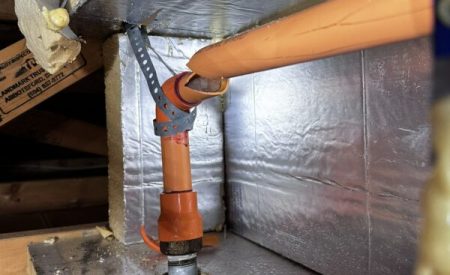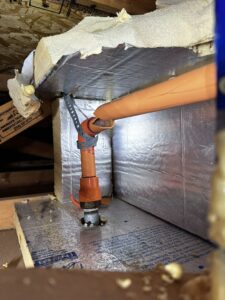It's that time of year where hard freezes set in, and bad industry practices that happened on the jobsite years back, turn into emergency repairs.
As temperatures plummet, the risk of frozen fire sprinkler pipes escalates, posing a significant challenge to fire safety systems. Empire Fire Protection, serving areas including Seattle, Tacoma, Kent, Sumner, and Puyallup, stands at the forefront of addressing and preventing these winter hazards. For a comprehensive overview of our services, visit our service areas page.
The Perils of Frozen Fire Sprinkler Pipes
Frozen fire sprinkler pipes are more than just a seasonal nuisance; they represent a critical failure in fire safety. When water inside these pipes freezes, it expands, potentially causing pipes to burst. This not only disrupts the effectiveness of a fire sprinkler system but can also lead to significant water damage and costly repairs once the temperatures rise back above freezing. Understanding the reasons why your sprinkler pipes froze in the first place is critical to preventing this from happening again in the future.

Causes of Frozen Sprinkler Pipes
The primary cause of frozen sprinkler pipes is inadequate insulation or heating in areas where sprinkler pipes are located. This is especially prevalent in unheated spaces like attics, basements, or garages. In commercial and larger residential settings, dry pipe systems are installed as required per NFPA 13. Unfortunately these systems are cost preventative in NFPA 13D residential applications; and contractors will use alternative acceptable methods to keep pipes conditioned (such as insulation tenting) to avoid them from freezing.
Another possible cause may be that the plan on how to prevent the pipes from freezing was not accurately given, or executed correctly by the general contractor or their subcontractors. For instance, below you will see an image of a "chase" that was constructed out of ridged insulation and sealed around the wet fire sprinkler line. While in theory this could be an acceptable approach, depending on the area the system is located, the execution of the plan did not allow for enough warm air to pass through into the chase, resulting in a frozen pipe scenario.
A better approach to this design would have been to install dry sidewalls instead of dry pendants, as the unheated exterior canopy could have been adequately protected with sidewall type sprinklers, and the wet sprinkler pipe would not have been exposed to the unheated airspace.
An even better approach would have been to just run these sprinklers off the dry system that was feeding the attic system.
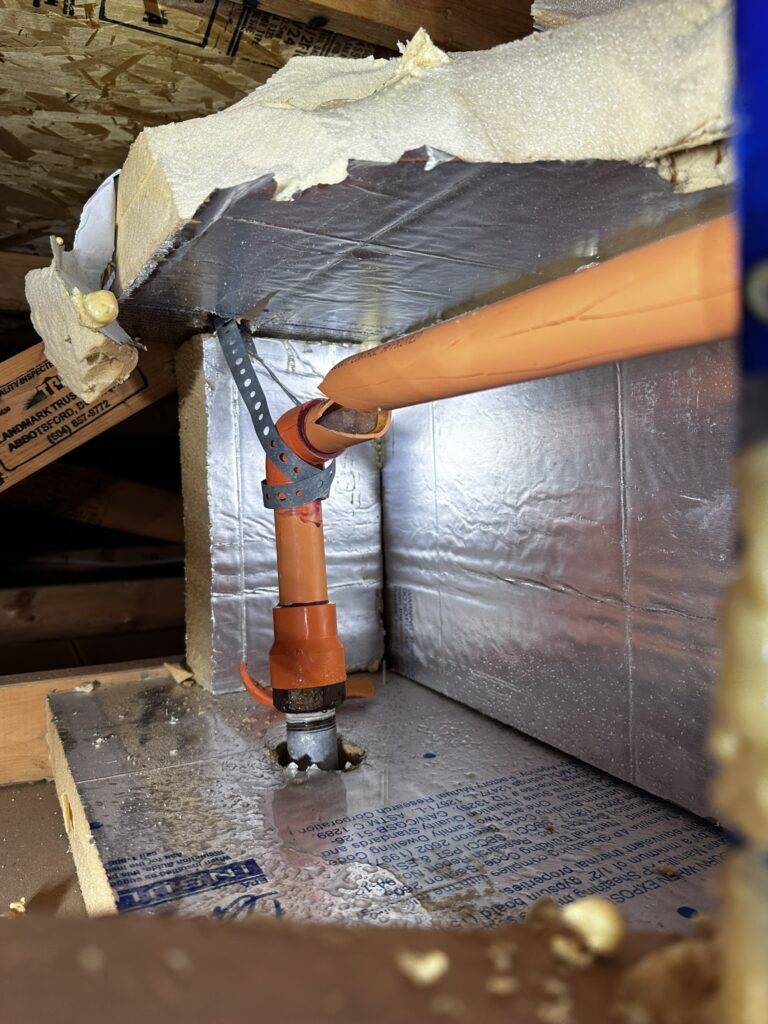
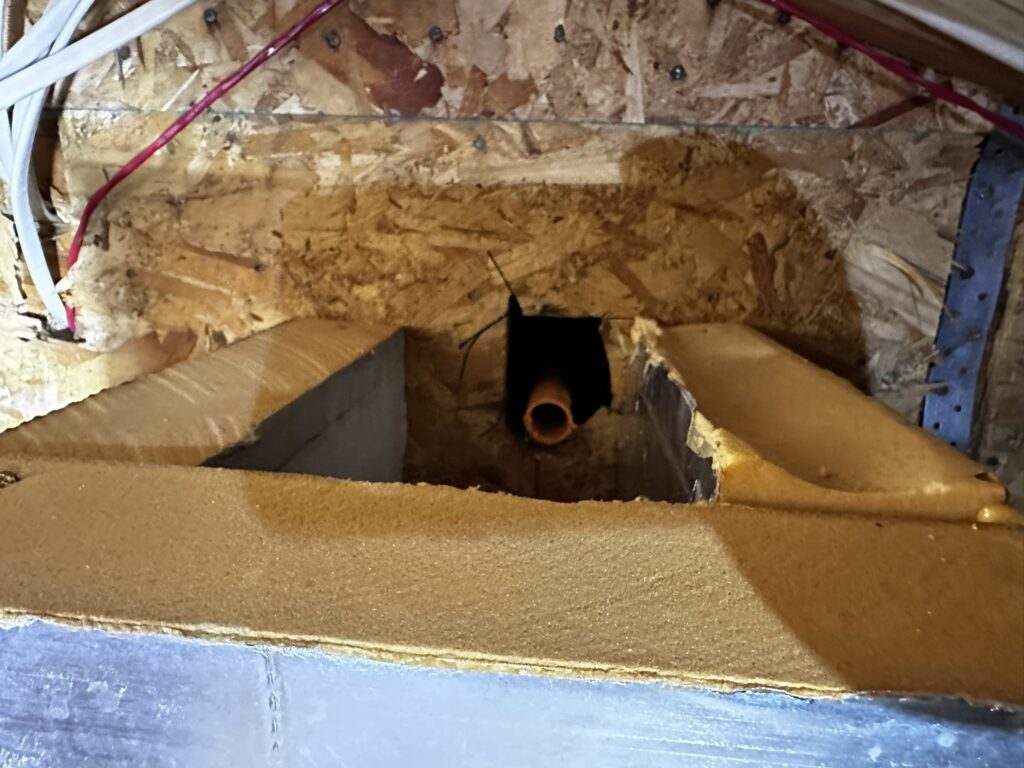
As you can see, the hole around this piping is nowhere near large enough for this approach to work as intended. Ample amounts of warm air must be able to reach the sprinkler pipe in order for it to not freeze. Keep in mind, this system was almost 20 years old. It just takes one hard freeze on any given year to cause a catastrophe. (Note: Empire Fire Protection did not install this system)
The Damage: Beyond the Ice
When sprinkler pipes freeze and burst, the damage extends beyond the immediate water leakage. It compromises the building's fire protection system, leaving it vulnerable in the event of a fire. This risk is heightened in settings with specific fire safety needs, such as assisted living facilities or facilities containing high hazard materials.
Being that it's probably the middle of winter when this event happens, your building has virtually no way of drying out. Wet wood often results in mold or pest related issues down the road. Drywall, sheathing, insulation and possibly finish material may need to be removed in order to access the pipes for a repair to be done. More than likely, your fire sprinkler contractor is only going to fix the immediate problem and you will need to hire other subcontractors to remediate the problems that arose due to the water damage.
Preventative Measures for Frozen Sprinkler Pipes
Preventing frozen fire sprinkler pipes has multiple approaches, all which need to be executed properly at the time of installation, in order for them to be effective. Below are a few approaches that can be deemed "acceptable".
- Dry Pipe System - This is the standard when it comes to commercial fire sprinkler systems and required for piping subject to areas that cannot be maintained above 40°F.
- Regular inspections by qualified professionals - Even if you have a dry system, it won't do any good if the system is not maintained and inspected on an annual basis. Pipes can house trapped water that needs to be drained via low point drains on a regular basis.
- Maintaining a consistent building temperature - This is critical in residential applications where sprinkler piping is ran in the trusses and insulation is "tented" over the piping. This insulation creates a warm pocket of air between the insulation and your ceiling, theoretically keeping your pipes warm enough to not freeze.
- Listed antifreeze solutions - For a while antifreeze systems were somewhat popular. This is a long story but when the glycerin, used as a component in the systems antifreeze actually caused a fire to rapidly expand, the codes changed and required the antifreeze in fire sprinkler systems to be listed for use in fire protection systems- makes sense. Well, there were actually no "listed" antifreeze solutions on the market until 2018, so there was a rapid decrease in these systems popularity. Now there are a few manufacturers who have listed, pre-mixed antifreeze solutions and we may start to see more of these systems come into service in the next decade. The one drawback with these systems, specifically in a residential application, is the requirement that annual testing of the antifreeze solution must be done. Currently, a homeowner can easily perform the testing of their home fire sprinkler system, but the required knowledge of testing antifreeze with a refractometer would more than likely require the service of a professional.
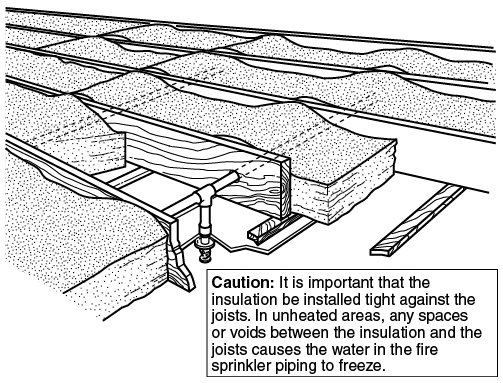
Insulation tenting detail | Source: NFPA 13D 2019 ed. Figure A.9.1.1(a) Insulation Recommendations — Arrangement 1.
Empire Fire Protection’s expertise in fire sprinkler system maintenance is vital in ensuring your system is winter-ready.
Solutions and Responses to Frozen Pipes
If you suspect your fire sprinkler pipes are frozen, prompt action is crucial. Contacting a professional fire sprinkler contractor, like Empire Fire Protection, can mitigate further damage. For immediate assistance, visit our contact page.
If this is a problem that continues to occur on an annual basis, it is time to find a solution. A dry system may be in order, or there may be other potential remedies that will prevent your pipes from freezing.
At Empire Fire Protection, our team of experts specializes in diagnosing and resolving issues related to frozen fire sprinkler pipes. Whether it's a residential building or a commercial property, our solutions are tailored to ensure your fire protection system remains functional and effective year-round. For insights into choosing a local expert, see why selecting a fire sprinkler contractor near you is important.
Safeguarding Against Winter's Chill
As winter sets in, the integrity of your fire sprinkler system must remain uncompromised. Empire Fire Protection offers comprehensive solutions to prevent and address the freezing of fire sprinkler pipes, ensuring your safety and peace of mind. We understand the importance of a reliable fire protection system and are dedicated to maintaining its health through every season.
For property owners who value the safety and efficiency of their fire protection systems, Empire Fire Protection is a trusted ally. We bring expertise, dedication, and timely solutions to ensure your fire sprinklers remain operational and effective, even in the coldest temperatures. To discuss how we can fortify your fire safety measures against the winter freeze, we welcome you to reach out to us for a consultation.

